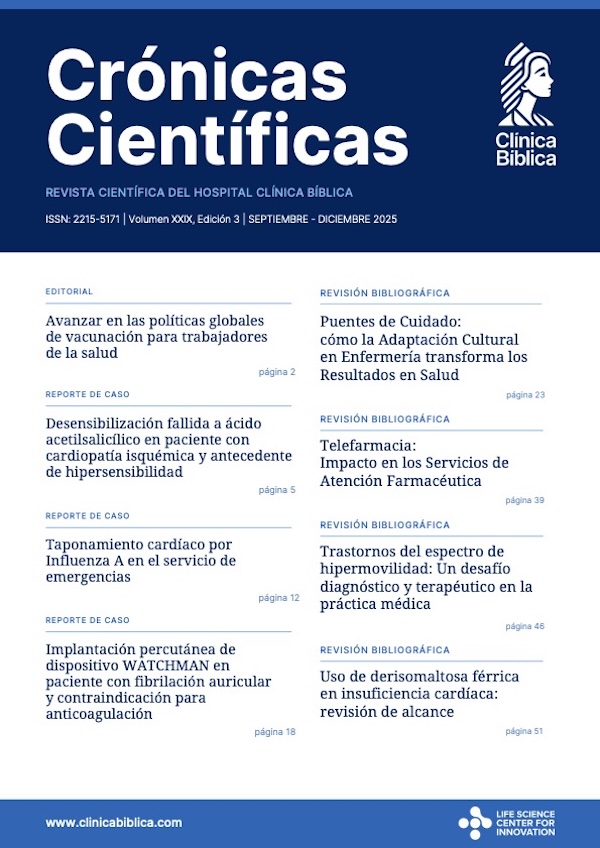- Visto: 1102
Prevención de Isquemia Medular en Cirugía Aórtica
Prevention of Spinal Cord Ischemia in Aortic Surgery
Edición XXI Mayo - Agosto 2022
DOI: https://doi.org/10.55139/TAVG3423
APA (7ª edición)
Sandoval R., Rojas Jiménez S., Sandoval AL., & Volio González M., (2022).Prevención de isquemia modular en cirugía aórtica. Crónicas Científicas, 21(21), 43-60. https://doi.org/10.55139/TAVG3423.
Vancouver
Sandoval R., Rojas Jiménez S., Sandoval AL. & Volio González M., (2022). Prevención de isquemia modular en cirugía aórtica. Cron Cient. 2 de mayo de 2022; 21(21): 43-60.
Dr. Luis Raúl Sandoval
Médico Especialidad en Cirugía Vascular Periférico
Caja Costarricense del Seguro Social
San José, Costa Rica.
Dra. Sofía Rojas Jiménez
Médico General
Licenciatura y Doctorado en Medicina y Cirugía.
Investigadora independiente
San José, Costa Rica.
Dra. Ana Laura Sandoval
Médico General
Licenciatura y Doctorado en Medicina y Cirugía.
Investigadora independiente
San José, Costa Rica.
Dra. Michelle Volio González
Médico General
Licenciatura y Doctorado en Medicina y Cirugía.
Investigadora independiente
San José, Costa Rica.
Resumen
La cirugía aórtica es un procedimiento que ha venido en evolución en los últimos años. Sin embargo, continúan existiendo complicaciones devastadoras a nivel de médula espinal que son limitantes para la realización segura de la misma.
La patogénesis de la lesión medular puede presentarse durante la cirugía o posterior a esta. Es multifactorial, pudiendo presentarse como una reducción temporal o permanente del flujo sanguíneo espinal. La isquemia medular y la paraplejía concomitante son de las complicaciones más temidas de la reparación endovascular de aneurisma aórtico-torácica. Ante esto se debe realizar una detección temprana debido a que permite el inicio de medidas anti-isquémicas antes de llegar a infarto medular y paraplejía permanente, utilizando monitoreos potenciales somatosensoriales evocados (SSEP) y/o motores evocados (MEP). Estos procedimientos ofrecen al equipo quirúrgico una oportunidad de revertir la causa de la hipoperfusión, maximizando la perfusión medular y revirtiendo la injuria espinal.
Existen múltiples protocolos que se enfocan en optimizar la perfusión medular y disminuir las demandas metabólicas y de oxígeno además de promover una detección rápida de déficit neurológico. Para esto, las guías internacionales actuales mencionan diferentes estrategias de prevención, donde por ejemplo para el caso de TEVAR, se recomiendan evitar períodos de hipotensión y el uso selectivo de drenaje fluido cerebroespinal en pacientes de alto riesgo de lesión isquémica espinal.
Palabras claves
Cirugía aórtica, isquemia medular, aneurisma aórtico torácico.
Abstract
Aortic surgery is a procedure that has been evolving in recent years. However, there are still devastating complications at the spinal cord level that are limiting for its safe performance.
The pathogenesis of spinal cord injury can occur during, or after, surgery. It is multifactorial and can present as a temporary or permanent reduction in spinal blood flow.
Spinal cord ischemia and concomitant paraplegia are one of the most feared complications of endovascular repair of thoracic aortic aneurysm. In view of this, early detection must be carried out because it allows the initiation of anti-ischemic measures before reaching spinal cord infarction and permanent paraplegia.
Using somatosensory evoked potential (SSEP) and/or motor evoked potential (MEP) monitoring, offer the surgical team an opportunity to reverse the cause of hypoperfusion, maximizing spinal cord perfusion and reversing spinal injury.
There are multiple protocols that focus on optimizing spinal cord perfusion and reducing metabolic and oxygen demands, as well as promoting early detection of neurological deficit. The current international guidelines mention different prevention strategies, where, for example, in the case of TEVAR, it is recommended to avoid periods of hypotension and the selective use of cerebrospinal fluid drainage in patients at high risk of spinal ischemic injury.
Keywords
Aortic surgery, medullar isquemia, thoracic aortic aneurysm.
Bibliografía
1. Melissano G, Chiesa R. Aortic Complexities. Milano: Edi-Ermes; 2018.
2. Dijkstra ML, Vainas T, Zeebregts CJ, Hooft L, van der Laan MJ. Spinal Cord Ischaemia in Endovascular Thoracic and Thoraco-abdominal Aortic Repair: Review of Preventive Strategies. J Vasc Surg. 2018;68(1):312. doi:10.1016/j.jvs.2018.05.004
3. Etz CD, Weigang E, Hartert M, et al. Contemporary spinal cord protection during thoracic and thoracoabdominal aortic surgery and endovascular aortic repair: a position paper of the vascular domain of the European Association for Cardio-Thoracic Surgery†. Eur J Cardiothorac Surg. 2015;47(6):943-957. doi:10.1093/ejcts/ezv142
4. Oderich GS. Endovascular Aortic Repair: Current Techniques with Fenestrated, Branched and Parallel Stent-Grafts. New York, NY: Springer Science+Business Media; 2016.
5. Chiesa R, Chiesa R, Melissano G, Zangrillo A, Coselli JS. Thoraco-Abdominal Aorta: Surgical and Anesthetic Management. New York: Springer-Verlag; 2011. https://doi.org/10.1007/978-88-470-1857-0. Accessed December 24, 2019.
6. Sidawy AN, Perler BA, eds. Rutherford’s Vascular Surgery and Endovascular Therapy. Ninth edition. Philadelphia, PA: Elsevier; 2019.
7. Biglioli P, Roberto M, Cannata A, et al. Upper and lower spinal cord blood supply: the continuity of the anterior spinal artery and the relevance of the lumbar arteries. J Thorac Cardiovasc Surg. 2004;127(4):1188-1192. doi:10.1016/j.jtcvs.2003.11.038
8. Etz CD, Kari FA, Mueller CS, et al. The collateral network concept: A reassessment of the anatomy of spinal cord perfusion. J Thorac Cardiovasc Surg. 2011;141(4):1020-1028. doi:10.1016/j.jtcvs.2010.06.023
9. Daube JR, Rubin DI, eds. Clinical Neurophysiology. 3rd ed. Oxford ; New York: Oxford University Press; 2009.
10. Chiesa R, Melissano G, Marrocco-Trischitta MM, Civilini E, Setacci F. Spinal cord ischemia after elective stent-graft repair of the thoracic aorta. J Vasc Surg. 2005;42(1):11-17. doi:10.1016/j.jvs.2005.04.016
11. Safi HJ, Miller III CC, Azizzadeh A, Iliopoulos DC. Observations on delayed neurologic deficit after thoracoabdominal aortic aneurysm repair. J Vasc Surg. 1997;26(4):616-622. doi:10.1016/S0741-5214(97)70060-0
12. Uchida N. How to prevent spinal cord injury during endovascular repair of thoracic aortic disease. Gen Thorac Cardiovasc Surg. 2014;62(7):391-397. doi:10.1007/s11748-014-0395-9
13. Czerny M, Eggebrecht H, Sodeck G, et al. Mechanisms of Symptomatic Spinal Cord Ischemia After TEVAR: Insights From the European Registry of Endovascular Aortic Repair Complications (EuREC). J Endovasc Ther. 2012;19(1):37-43. doi:10.1583/11-3578.1
14. Melissano G, Bertoglio L, Mascia D, et al. Spinal cord ischemia is multifactorial: what is the best protocol? J Cardiovasc Surg (Torino). 57(2):13.
15. Stanger OH, Pepper JR, Svensson LG. Surgical Management of Aortic Pathology Current Fundamentals for the Clinical Management of Aortic Disease.; 2019.
16. Subramaniam K, Park KW, Subramaniam B, eds. Anesthesia and Perioperative Care for Aortic Surgery. New York: Springer; 2011.
17. Keyhani K, Miller CC, Estrera AL, Wegryn T, Sheinbaum R, Safi HJ. Analysis of motor and somatosensory evoked potentials during thoracic and thoracoabdominal aortic aneurysm repair. J Vasc Surg. 2009;49(1):36-41. doi:10.1016/j.jvs.2008.08.005
18. Dias-Neto M, Reis PV, Rolim D, Ramos JF, Teixeira JF, Sampaio S. Strategies to prevent TEVAR-related spinal cord ischemia. Vascular. 2017;25(3):307-315. doi:10.1177/1708538116671235
19. Bobadilla JL, Wynn M, Tefera G, Acher CW. Low incidence of paraplegia after thoracic endovascular aneurysm repair with proactive spinal cord protective protocols. J Vasc Surg. 2013;57(6):1537-1542. doi:10.1016/j.jvs.2012.12.032
20. Arnaoutakis DJ, Arnaoutakis GJ, Beaulieu RJ, Abularrage CJ, Lum YW, Black JH. Results of Adjunctive Spinal Drainage and/or Left Subclavian Artery Bypass in Thoracic Endovascular Aortic Repair. Ann Vasc Surg. 2014;28(1):65-73. doi:10.1016/j.avsg.2013.06.011
21. Acher C, Acher CW, Marks E, Wynn M. Intraoperative neuroprotective interventions prevent spinal cord ischemia and injury in thoracic endovascular aortic repair. J Vasc Surg. 2016;63(6):1458-1465. doi:10.1016/j.jvs.2015.12.062
22. Scali ST, Wang SK, Feezor RJ, et al. Preoperative prediction of spinal cord ischemia after thoracic endovascular aortic repair. J Vasc Surg. 2014;60(6):1481-1490.e1. doi:10.1016/j.jvs.2014.08.103
23. Ullery BW, Cheung AT, Fairman RM, et al. Risk factors, outcomes, and clinical manifestations of spinal cord ischemia following thoracic endovascular aortic repair. J Vasc Surg. 2011;54(3):677-684. doi:10.1016/j.jvs.2011.03.259
24. Hanna JM, Andersen ND, Aziz H, Shah AA, McCann RL, Hughes GC. Results With Selective Preoperative Lumbar Drain Placement for Thoracic Endovascular Aortic Repair. Ann Thorac Surg. 2013;95(6):1968-1975. doi:10.1016/j.athoracsur.2013.03.016
25. Feezor RJ, Martin TD, Hess PJ, et al. Extent of Aortic Coverage and Incidence of Spinal Cord Ischemia After Thoracic Endovascular Aneurysm Repair. Ann Thorac Surg. 2008;86(6):1809-1814. doi:10.1016/j.athoracsur.2008.09.022
26. Griepp RB, Griepp EB. Spinal Cord Perfusion and Protection During Descending Thoracic and Thoracoabdominal Aortic Surgery: The Collateral Network Concept. Ann Thorac Surg. 2007;83(2):S865-S869. doi:10.1016/j.athoracsur.2006.10.092
27. Laschinger JC, Cunningham JN, Cooper MM, Krieger K, Nathan IM, Spencer FC. Prevention of Ischemic Spinal Cord Injury Following Aortic Cross-Clamping: Use of Corticosteroids. Ann Thorac Surg. 1984;38(5):500-507. doi:10.1016/S0003-4975(10)64192-6
28. Davison JK, Cambria RP, Vierra DJ, Columbia MA, Koustas G. Epidural cooling for regional spinal cord hypothermia during thoracoabdominal aneurysm repair. J Vasc Surg. 1994;20(2):304-310. doi:10.1016/0741-5214(94)90020-5
29. Feezor RJ, Lee WA. Strategies for Detection and Prevention of Spinal Cord Ischemia during TEVAR. Semin Vasc Surg. 2009;22(3):187-192. doi:10.1053/j.semvascsurg.2009.07.011
30. Jayia P, Constantinou J, Hamilton H, Ivancev K. Temporary Perfusion Branches to Decrease Spinal Cord Ischemia in the Endovascular Treatment of Thoraco-Abdominal Aortic Aneurysms. AORTA. 2015;03(02):56-60. doi:10.12945/j.aorta.2015.14-045
31. Kasprzak PM, Gallis K, Cucuruz B, Pfister K, Janotta M, Kopp R. Editor’s Choice – Temporary Aneurysm Sac Perfusion as an Adjunct for Prevention of Spinal Cord Ischemia After Branched Endovascular Repair of Thoracoabdominal Aneurysms. Eur J Vasc Endovasc Surg. 2014;48(3):258-265. doi:10.1016/j.ejvs.2014.05.020
32. Luehr M, Salameh A, Haunschild J, et al. Minimally Invasive Segmental Artery Coil Embolization for Preconditioning of the Spinal Cord Collateral Network Before One-Stage Descending and Thoracoabdominal Aneurysm Repair. 2014;9(1):6.
33. von Aspern K, Haunschild J, Hoyer A, et al. Non-invasive spinal cord oxygenation monitoring: validating collateral network near-infrared spectroscopy for thoracoabdominal aortic aneurysm repair. Eur J Cardiothorac Surg. 2016;50(4):675-683. doi:10.1093/ejcts/ezw063
34. Etz CD, von Aspern K, Gudehus S, et al. Near-infrared Spectroscopy Monitoring of the Collateral Network Prior to, During, and After Thoracoabdominal Aortic Repair: A Pilot Study. Eur J Vasc Endovasc Surg. 2013;46(6):651-656. doi:10.1016/j.ejvs.2013.08.018
35. Scott DA, Denton MJ. Spinal cord protection in aortic endovascular surgery. Br J Anaesth. 2016;117:ii26-ii31. doi:10.1093/bja/aew217
36. Weigang E, Hartert M, Sircar R, et al. Setup of Neurophysiological Monitoring with tcMEP/SSEP During Thoracoabdominal Aneurysm Repair. Thorac Cardiovasc Surg. 2005;53(1):28-32. doi:10.1055/s-2004-830431
37. Achouh PE, Estrera AL, Miller CC, et al. Role of Somatosensory Evoked Potentials in Predicting Outcome During Thoracoabdominal Aortic Repair. Ann Thorac Surg. 2007;84(3):782- 788. doi:10.1016/j.athoracsur.2007.03.066
38. Weigang E, Sircar R, von Samson P, et al. Efficacy and Frequency of Cerebrospinal Fluid Drainage in Operative Management of Thoracoabdominal Aortic Aneurysms. Thorac Cardiovasc Surg. 2007;55(2):73-78. doi:10.1055/s-2006-924708
39. Awad H, Ramadan ME, El Sayed HF, Tolpin DA, Tili E, Collard CD. Spinal cord injury after thoracic endovascular aortic aneurysm repair. Can J Anesth Can Anesth. 2017;64(12):1218-1235. doi:10.1007/s12630-017-0974-1
40. Amabile P, Grisoli D, Giorgi R, Bartoli J-M, Piquet P. Incidence and Determinants of Spinal Cord Ischaemia in Stent-graft Repair of the Thoracic Aorta. Eur J Vasc Endovasc Surg. 2008;35(4):455-461. doi:10.1016/j.ejvs.2007.11.005
41. Cheung AT, Pochettino A, McGarvey ML, et al. Strategies to Manage Paraplegia Risk After Endovascular Stent Repair of Descending Thoracic Aortic Aneurysms. Ann Thorac Surg. 2005;80(4):1280-1289. doi:10.1016/j.athoracsur.2005.04.027
42. Martin DJ, Martin TD, Hess PJ, Daniels MJ, Feezor RJ, Lee WA. Spinal cord ischemia after TEVAR in patients with abdominal aortic aneurysms. J Vasc Surg. 2009;49(2):302-306. doi:10.1016/j.jvs.2008.08.119
43. Shahin G, Hamerlijnck R, Schepens M, Vermeulen F, Terbeek H, Boezeman E. Upper and lower extremity somatosensory evoked potential recording during surgery for aneurysms of the descending thoracic aorta. Eur J Cardiothorac Surg. 1996;10(5):299-304. doi:10.1016/S1010-7940(96)80086-8
44. Banga PV, Oderich GS, Reis de Souza L, et al. Neuromonitoring, Cerebrospinal Fluid Drainage, and Selective Use of Iliofemoral Conduits to Minimize Risk of Spinal Cord Injury During Complex Endovascular Aortic Repair. J Endovasc Ther. 2016;23(1):139-149. doi:10.1177/1526602815620898
45. Chaikof EL, Cambria RP, eds. Atlas of Vascular Surgery and Endovascular Therapy: Anatomy and Technique. Philadelphia, PA: Elsevier Saunders; 2014.
46. Yanase Y, Kawaharada N, Maeda T, et al. Treatment of Delayed Neurological Deficits after Surgical Repair of Thoracic Aortic Aneurysm. Ann Thorac Cardiovasc Surg. 2012;18(3):271-274. doi:10.5761/atcs.cr.11.01741
47. Jafarzadeh F, Bashir M, Yan T, et al. Setting up and utilizing a service for measuring perioperative transcranial motor evoked potentials during thoracoabdominal aortic surgery and thoracic endovascular repair. Interact Cardiovasc Thorac Surg. 2014;18(6):748-756. doi:10.1093/icvts/ivu036
APA (7ª edición)
Sandoval R., Rojas Jiménez S., Sandoval AL., & Volio González M., (2022).Prevención de isquemia modular en cirugía aórtica. Crónicas Científicas, 21(21), 43-60. https://doi.org/10.55139/TAVG3423.
Vancouver
Sandoval R., Rojas Jiménez S., Sandoval AL. & Volio González M., (2022). Prevención de isquemia modular en cirugía aórtica. Cron Cient. 2 de mayo de 2022; 21(21): 43-60.
Esta obra está bajo una licencia internacional Creative Commons: Atribución-NoComercial-CompartirIgual 4.0 Internacional (CC BY-NC-SA 4.0)

Realizar búsqueda
Última Edición
Ediciones Anteriores






